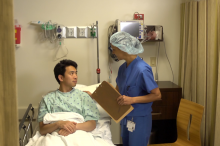Orbital surgery due to trauma, disease, or congenial defect can be an emotional subject. The orbital area (including the eyes, eye sockets, muscles, and surrounding tissues) is a highly compact and very delicate area that requires the utmost skill and precision.
Our Beverly Hills team of experienced orbital surgeons believes that educating people about the different types of orbital surgery is the best way to put their minds at ease.
Here are some of the frequently asked questions about orbital conditions and surgeries:
When is socket reconstructive surgery necessary?
Socket reconstructive surgery is usually necessary after any type of eye trauma, defects, or scarring in the general eye area from disease or accident causing the loss of an eye.
What is socket reconstructive surgery?
Eye socket reconstruction is a surgical procedure that restores function and provides rehabilitation to the soft tissues and bone around the eye including the eyelids, socket, and conjunctival fornices.
Who preforms socket reconstructive surgery?
An oculoplastic surgeon at our surgical center in Beverly Hills will perform your socket reconstructive surgery. An oculoplastic surgeon is a plastic surgeon who specializes in reconstructive surgery.
What kind of doctor should treat an orbital tumor?
When choosing a surgeon to evaluate and treat your orbital problem, look for an ophthalmic facial plastic & reconstructive surgeon who specializes in the eyelid, orbit, and tear drain surgery. It is important that our Beverly Hills oculofacial surgeons not only understand the orbit area and eye, but also has qualifying experience in ophthalmic plastic surgery to comprehensively understand your condition.
Where do orbital tumors occur?
Orbital tumors can occur in the bones, muscles, tissue, and blood vessels of the orbit area that houses the eyeball. Orbital tumors can also occur on or behind the eye.
What is eyelid reconstruction?
Eyelid reconstruction is a carefully planned procedure preformed by an oculoplastic surgeon with extensive knowledge of the orbital area and eye structure.
What is Mohs Eyelid Reconstruction?
Mohs’ surgery is a procedure developed specifically to remove a cancerous skin lesion, using visualization under microscope to carefully remove the cancerous lesion layer by layer until all margins are free of any cancerous tissue.
What is eyelid retraction?
Eyelid retraction is a condition in which the eyelids are too wide open and the lid moves away, retracting from the surface of the eye.
How is eyelid retraction treated?
Eyelid retraction is usually treated with lubricating eye drops and ointment until surgery can be performed to bring the eyelids back to their normal resting place.
What causes eyelid retraction?
Eyelid retraction is usually caused by past eye trauma, thyroid eye disease, or loss of tone due to aging.
What is Grave’s Disease?
Grave’s disease is an autoimmune disease in which the thyroid produces an excessive amount of hormones, causing the eye trouble in the form of swollen eye muscles and tissues
What are some symptoms of Grave’s Disease?
Symptoms of thyroid eye disease usually involve impaired or double vision, inflammation and swelling of eye tissues, dry eye, bloodshot appearance, and an overall pain the eyes.
What is the treatment for Grave’s Disease?
Treatment for Grave’s Disease includes both surgical and non-surgical options. Nonsurgical options usually take the form of lubricating or antibiotic eye drops to relieve symptoms. For more serious cases, orbital decompression allows the eye to return to it’s normal position.
Why do the eyes bulge?
In most cases of thyroid eye disease, eyes appear to be bulging due to excessive swelling of eye tissue.
Next, read our blog.
To make an appointment with one of our top of the line eye surgeons, please contact (888) 559-4341 today!














